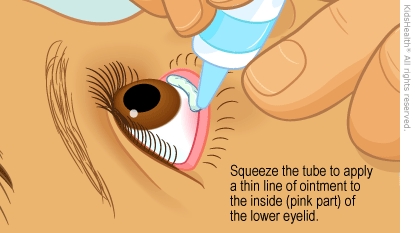Your child had surgery to open a blocked tear duct. The surgeon prescribed antibiotic ointment or drops to prevent infection while your child heals. It may take a week or so for your child's tears to start to drain normally.

- If your child seems uncomfortable and the surgeon says it's OK, you can give medicine for pain. Use these medicines exactly as directed:
- acetaminophen (such as Tylenol® or a store brand)
OR
- ibuprofen (such as Advil®, Motrin®, or a store brand). Do not give ibuprofen to babies under 6 months old.
- If your child has blood in the tears or a small amount of blood from the nose, wipe the area with a warm, wet washcloth. This is normal in the first few days after surgery.
- If your child had general anesthesia (slept during surgery), let them start eating and drinking a little at a time. It can take a day or two to get back to a regular diet.
- It is OK to bathe and wash hair as usual.
To use the antibiotic eye ointment or drops:
- Wash your hands with soap and water. Dry with a clean towel.
- Have your child lie down on their back.
- To keep your hand steady, rest your wrist lightly on your child's face.
- Hold the tube or bottle above the eye.
- Do not let the tip of the tube or bottle touch your child's eye or eyelid, your hands, or anything else.
- Gently pull down your child's lower eyelid.
- For ointment:
- Hold the medicine tube in your hands for a few minutes to warm it. Don't microwave the medicine.
- Squeeze the tube to apply a thin line of ointment to the inside (pink part) of the lower eyelid. Start near the nose and move out toward the ear. Usually, a ½-inch (1-centimeter) line of ointment is enough.
- For drops:
- Shake the bottle before using, if recommended.
- Put the recommended number of drops inside the lower eyelid.
- Wipe away any excess ointment or drops from the eyelids and eyelashes with a clean tissue.

What happens with a blocked tear duct? Tears are made under the eyelids and drain through the tear ducts into the nose. When a baby is born with a blocked tear duct, the tears can't drain into the nose. The duct may be too narrow or have a web of tissue blocking it. The tears get backed up and come out the eyes. The eyes may get crusty and irritated.
What do surgeons do to open a blocked tear duct? Surgeons can open a blocked tear duct in different ways, including:
- using a thin wire (called a probe) to clear the duct; this is most common
- placing a stent (tiny tube) into the duct to hold it open
- inflating a tiny balloon inside the duct to widen it
What if my child's eye begins to tear again? Sometimes it takes more than one surgery to open a blocked tear duct. If a probe was used the first time, the surgeon may try it again or do a different surgery.



